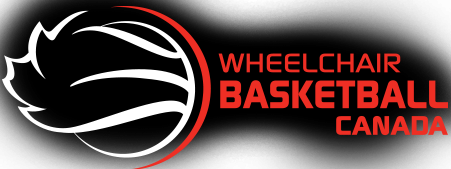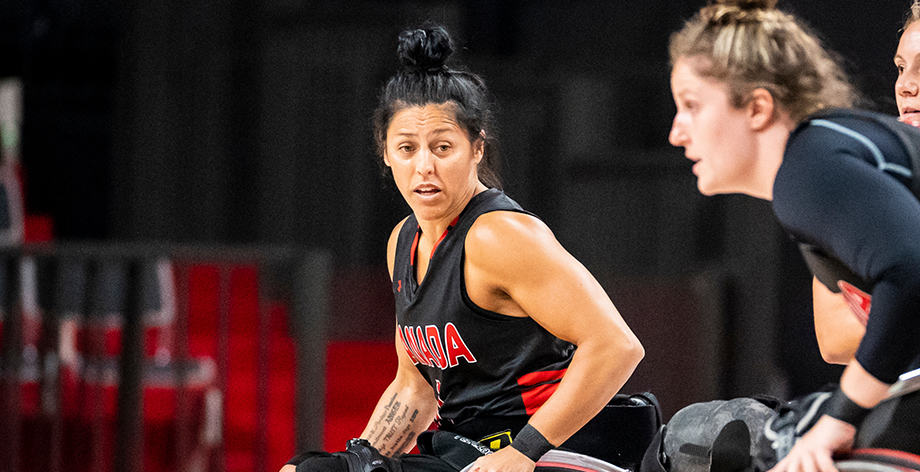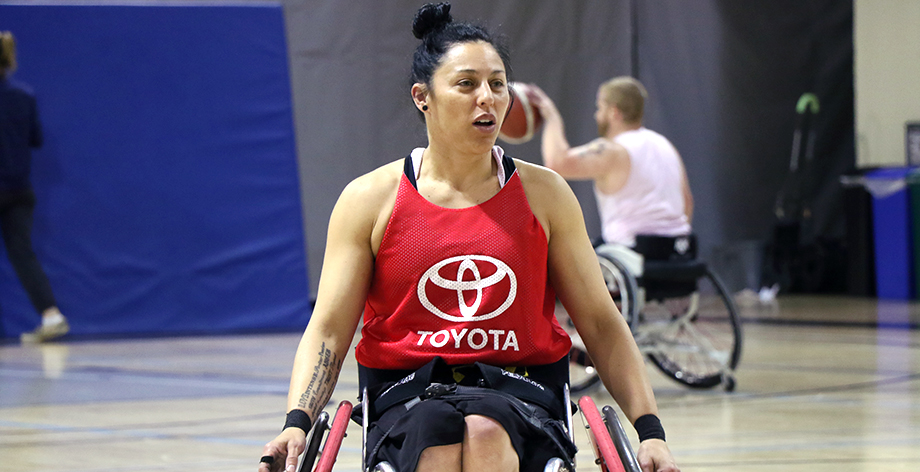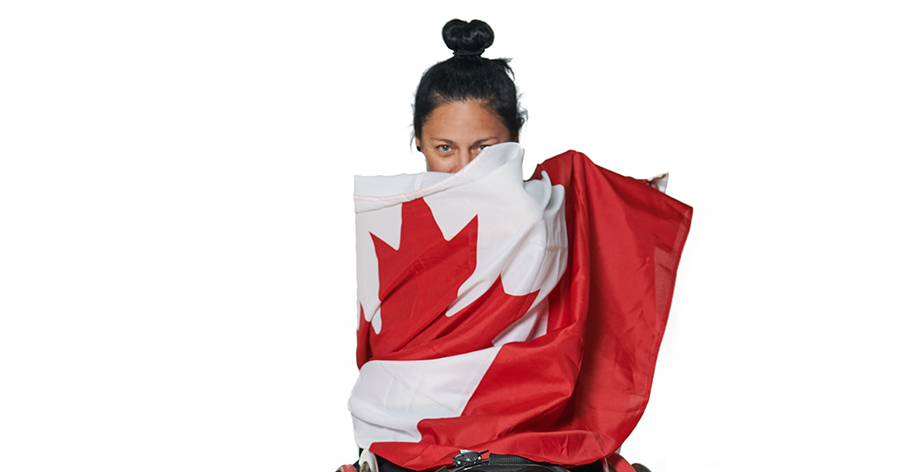Tara writes about her journey from growing up in Southern California and discovering BMX racing to her accident and finding adaptive sports in this month’s Athlete Spotlight presented by Toyota.
I was born in West Covina, California, and grew up in Southern California. Life growing up in Southern California was pretty great. I played every sport you could think of, and it was actually a great environment to grow up in.
Finding the bike
I got into BMX racing because of a woman my mom worked with — her son was getting into BMX. Plus, we used to drive by the world-famous Orange “Y” BMX track all the time. The track was right off the 57 freeway. Every time we drove by, you could see all the lights. I was enamored with it. I’d never been in any sport like that before.
I grew up playing basketball, running track, and playing softball — so BMX was more of a fringe sport. I was so drawn to it. My mom’s coworker’s son was racing one night, and they invited us to go watch. I think I went the next week with my Pep Boys auto parts bike, and I raced. I was 11-12-years-old, and that kind of started the whole thing. That was it… I was IN!
I’d won races and some championships in BMX, but there is one race that really sticks out for me. I think I was 13 years old and racing the biggest race in the US, the Grand Nationals in Oklahoma. This was the big one after racing something like 20 races all over the country. The one that people remembered. I got into the eight-rider gate, the gate went down, and I came out dead last. I mean dead last! I managed to pick every single rider off, and in the previous turn I made a pass from second into first place, and I won the race.
That one I’ll never forget.
About five years later, I started racing mountain bikes which was a really new sport at the time; and was getting really big. At the time, a lot of BMXers had good bike handling skills, so they started to get recruited by mountain bike teams.
The BMX company I was sponsored by was Haro Bikes, and they also had a mountain bike team, so they invited me out to a mountain bike race. I think I came in second place, and I started to migrate in that direction. The bonus was that you could make a living racing mountain bikes. At the time, there was a lot of outside-the-industry sponsor money coming into the sport.
With BMX, you could make some money, but it wasn’t something you could live on. So, I decided to make the transition, and give it a go. I moved from California to Colorado.
Colorado was the place to be. It seemed like all of the good mountain bikers lived in either California or Colorado; I decided to quit basketball, move to Colorado, and give it a go.
Basketball was my first love, then came BMX, and then mountain biking. It was like this graduation from BMX to mountain biking.
The accident
September 1, 2007 — it was a made-for TV event called the ‘Jeep King of the Mountain’ race in Vail, Colorado. It was the later stages of my mountain bike career, and I was already thinking about retirement. I was going to go to Worlds in Fort William, Scotland, the next weekend and then retire.
The Jeep King of the Mountain race is a mix of slalom and downhill, all on one course. You had a blue course and a red course; it was a made-for-TV event so when TV says ‘go’, the gates open, and you have to go. You’re racing head-to-head with another rider, but you’re on separate courses. After 3-5 gates, the courses join, and you’re racing on the same course against each other the rest of the way down. The premise is you start on the blue course, race down, and if you lose your head-to-head race by .5 seconds, you go back up, switch to the red course, and then I’d need to beat her by more than .5 seconds to advance.
On that day, we were in the gate, and it was like I had a premonition. When you get in the gate, you stand up on your pedals to set them in a certain way, and they just didn’t feel like they were in the right spot. My goggles weren’t in the right spot on my helmet, and I just wasn’t ready. I had a bad feeling, and I’d never felt that before. Then they said, ‘red course ready, blue course ready, racers ready,’ the gates opened, and I started racing. I was all over the place and couldn’t focus. My competitor was way ahead of me.
We’re coming into the midsection of the course, and there were some sizeable jumps. I’d hit them fine in practice, but they were tricky. As I’m coming up to it, I was debating in my head, ‘Do I jump it? Do I not? What if she falls, and I jump them it, then I can pass her.’ There’s all these things that are going on in my head in the span of about two seconds. It was like my brain short-circuited.
My last thought was to jump it. There was a little roller before, and I think what happened was I tapped it with my front wheel on accident, and then my head hit the face of the jump where I was supposed to be taking off.
I was going 20-plus miles per hour and landed straight on top of my head. My bike had nowhere to go, and I was clipped into my pedals. My head came to a dead stop, and then my body came over the top. The initial impact broke my neck. Then when my legs scorpioned over my head, that’s what broke my back. Luckily my neck healed. Otherwise, I think my life would have been quite a bit different.
The official diagnosis was paralysis T-12, L-1 paralysis.
Introduction to Wheelchair Basketball
I was living in the States, and I ended up moving up to Canada. The person I was dating at the time was living in Vancouver, which brought me to the city.
I didn’t play sports for probably 5-6 years. It was the longest I’d gone in my entire life without sports. I felt so lost. I really didn’t know what I wanted to do with my life and had felt like I had lost my identity. Before the accident, I was always an athlete. Now I didn’t have that, and I didn’t really know anybody in Canada except my partner, so it was a really tough time for me.
My partner at the time ended up getting me a wheelchair tennis lesson as a present because my birthday was coming up. I went, and I just fell in love with it.
It was at that moment that I had a focus. That’s what really led me to where I am today.
I met Richard “Bear” Peter playing tennis, Amanda Yan and Marni Abbott-Peter too —I met everyone playing tennis.
Bear was telling me if I wanted to get faster on the tennis court, that I should play some basketball.
Then I kind of started going to some practices —it was Amanda Yan that kind of put me over the top. She was like ‘T you really got to play.’
Selling adaptive mountain bikes
Some friends of mine did a fundraiser, and I saw this bike that was made in Poland called a SPORT-ON— it was one of the most advanced adaptive mountain bikes at the time. They were able to import it and bring it into Canada.
When I was out on the trails with it, people would always ask me, ‘oh my god, what is that?’ —there were so many people— and I was thinking to myself, ‘I can’t be the only paralyzed person that would want to get out on the trails.’
It was at that moment I wondered why there was no Canadian rep. So, I just cold-called the owner of SPORT-ON. I told them my story. I said, ‘hey, I used to race mountain bikes, I’m familiar with mountain bikes, I want to sell these.’
I knew nothing about sales. I knew nothing about how to run my own business, but I just shot my shot and they said ‘yeah’. I think it was helpful because I think he knew of me through mountain biking so that was sort of my foot in the door.
They said, ‘yes’ and now I’m selling these bikes, and I was like, ‘now what do I do?’
Fortunately, my ex is in sales, and she was the one who taught me how to set up my business. It was a lot of years of making a lot of mistakes and figuring it out. I’ve been selling them now since 2014, and it’s been great. I love it.
First paralympic experience
The experience in Tokyo was a tough one.
You’ve worked so hard through all your practices, through Covid-19, through classification, through not knowing once you get there, is someone going to test positive? We’re all travelling together. The pressure and the weight was so heavy. It was like that for every team. I’m not saying it was just Canada.
One of the hardest parts was rolling into the arena, this beautiful arena that the Japanese people had built – and there was nobody there – knowing that all of our games were sold out and knowing pre-COVID that the arena was going to be packed. I wanted that full Paralympic experience with friends, family, and fans.
For me, it may very well have been my one and only Paralympics, so it’s tough.
At the same time, I’m proud of the team and proud of what we’ve been able to do— who we are as individuals. You kind of have to pick apart different things. It wasn’t all doom and gloom. I’m proud to have gone there and had Canada across my chest and represented this country.
Advice for new athletes
Get in touch with your local adaptive organization or club and start from the grassroots level.
We, of course, hope you end up falling in love with wheelchair basketball, but even if you don’t we hope it gives you a sense of community. I know when I was playing tennis, I didn’t want to be around anyone else that was in a chair because then it made me realize that that was my life, that this was actually happening.
When I look back it’s hard to believe I felt that way, but everything felt so heavy, and I was dealing the best I could. The thing I didn’t realize at the time was that this new community was my resource. They knew exactly what I was going through, and they taught me so much and so much quicker than if I was doing it alone.
I love this community so much. I think, at the very least, for someone that wants to get into the sport, you have that community to talk to and to grow with.
Also, for people who have a minimal disability that want to play this sport, wheelchair basketball is probably the most inclusive sport of the wheelchair sports.
It’s awesome because our 4.5 classification players and minimally disabled players get to see the other side of things. They see what people in chairs have to deal with and go through on a daily basis, and I think it opens their eyes a bit more. Then they go out into the world and maybe recognize things that aren’t accessible, and then they can be advocates for us. Every little bit helps.
I love that.





